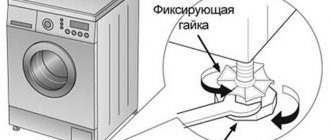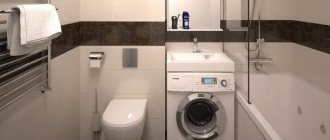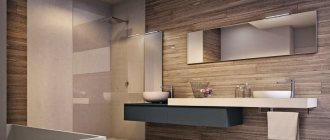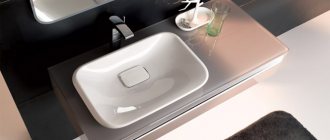To the sewer
If the hose is not lifted in this way, the water will pour out immediately after entering the machine.
The free end of the hose can be lowered into the toilet, bathtub or sink. This is not the best option because it is uncomfortable and the end may come off. Then the water will flood the floor, and maybe even reach the neighbors below.
There is a siphon under the sink. Remove the old siphon and install a special siphon with an additional hole for the hose.
- Make sure that the drain hose is not kinked. This makes it difficult for water to escape. Since the water is dirty, debris and dirt can accumulate at the bend.
- The hose must not be pulled. It should form a bend with a radius of 50 to 85 cm.
Accommodation options
There are several places where you can put a washing machine:
The most problematic option is the corridor. Usually there are no required communications in the corridor - no sewerage, no water. You will have to “pull” them to the installation site, which is not at all easy. But sometimes this is the only option. In the photo below there are several interesting solutions for how you can place the typewriter in the hallway.
The photo shows an option for installing a washing machine in a narrow corridor. Making something similar to a portal is also a solution. Hide it in a bedside table. Build it into hallway furniture.
The toilet has all communications, but in typical high-rise buildings the size of this room is such that it is sometimes difficult to turn around there - there is no space at all. In this case, washing machines are placed above the toilet. To do this, make a shelf so that when sitting on the toilet you do not touch it with your head. It is clear that it must be very durable and reliable, and the machine must have very good shock absorbers. In addition, they must be set perfectly, otherwise they may “jump away” during the spin cycle. In general, with this method of installing a washing machine, it doesn’t hurt to make several strips that will prevent it from falling off the shelf.
The shelf is solid and reliable, but slippery - a rubber mat is needed under the legs for shock absorption. Powerful corners are built into the wall, with a washing machine installed on them. The plastic stops were removed from the legs, and holes were drilled in the corners for the remaining screws
The installation is reliable, the only important thing is that vibration does not tear the corners out of the wall. You can close it with vertical blinds. This is already a whole cabinet. The only thing missing is the doors
In the bathroom and combined toilet there is usually not very much space either, but still more than in the toilet. There is a choice here. If you have space, you can place the washing machine next to the sink. You can install a table top on top, which will be a logical conclusion and will also solve the problem of water getting on the body. To make everything look organic, you need to choose a machine of such a height that it fits into the size, and the sink itself is better square - then they will be wall to wall. If there is not enough space, you can slide at least part of the body under the sink.
Place the washing machine next to the sink. Nowadays fashionable countertops in the bathroom can be decorated with mosaics. If space allows, simply place the machine next to the sink.
There is a more compact way - to place the washing machine under the sink. Only the sink needs a special shape so that the siphon is installed at the back.
To place the washing machine under the sink you need a special sink
One of the sinks under which you can put a washing machine
The next option for installing a washing machine in the bathroom is on the side of the bath - between its side and the wall. Today, case sizes can be narrow, so this option is a reality.
Narrow bodies are no longer a rarity Between the bathtub and the toilet The sink should not be smaller than the body No one bothers you to install a sink on top
Just keep in mind that installing such equipment in bathrooms or a combined bathroom is not the best idea. Due to increased humidity, the case begins to rust quickly (tested from my own experience). However, there is usually not a lot of space, although in principle, you can put the car under the washbasin or hang shelves above it. In general, it's up to you.
Another popular place to install a washing machine is in the kitchen. It is built into the kitchen set. Sometimes they close doors, sometimes they don’t. This is at the discretion of the owners. Several interesting photos are in the gallery.
Doors with a cutout for a “porthole” Place in a kitchen cabinet The washing machine looks quite organic in the kitchen unit
Options for installing a washing machine in the kitchen
How to position the washing machine so that it fits as seamlessly as possible into the kitchen interior and does not interfere with the comfortable use of the room? There are several convenient options for kitchens of different layouts and sizes.
Washing machine in the kitchen under the countertop
One of the simplest solutions is to place the washing machine in a niche under the kitchen countertop. This way you will provide convenient access to it and at the same time the equipment will not take up extra space in the room.
Photo: archidea.com.ua
The main thing is to choose a machine that matches the appearance of your interior, because its front panel will always be visible.
Behind the kitchen doors
A more advanced option for placing the washing machine under the countertop is to close it with cabinet doors. In this case, you may have to choose a model with reduced depth and partially sacrifice the drum volume. But there is no need to decorate the machine to match the kitchen interior.
Photo: dream-home-ideas.com
And remember that for comfortable use of the equipment, the doors must open wide and completely - this requires a lot of free space around the hidden machine.
Photo: moodecor.co
So in narrow or compact corner kitchens with a washing machine, it is better to leave the equipment simply under the countertop, without additional doors - this will significantly save space.
Built-in washing machine in the kitchen
If you simply place the machine under the tabletop, there will be cracks and gaps around it in any case, and the body may stick out - this will disrupt the integrity of the interior. Is this critical for you? Then choose a built-in washing machine - it is installed directly in the cabinet and has hinges on the body where the door is attached.
Photo: dream-home-ideas.com
This is a more compact solution suitable for small kitchens. The only negative: built-in models are more expensive than traditional ones.
Photo: decoratex.biz
Built-in models also offer several original placement options. For example, if all the cabinets are occupied, you can install a washing machine even at the end of the kitchen unit. This option is perfect for creating a small kitchen design with a washing machine.
Open location
If for some reason it is not possible to place the machine in the headset, you can choose free-standing equipment. The design of a kitchen with an open washing machine requires a lot of free space so that it does not interfere with movement around the room and does not block the main functional areas.
Photo: decoratex.biz
You can place such a machine behind a small partition, creating stylish zoning, or place something on its surface: household items or decorative ornaments.
Stage 1. Selecting a location for installation
Rules for the location of the washing unit
The operating rules for washing machines require compliance with a number of mandatory conditions for their installation. The base on which the unit is located must be level and strong, without horizontal distortions.
Otherwise, vibrations and beatings of rapidly rotating components and parts may occur, which leads to premature wear of expensive equipment. For the same reason, you should not place the machine on soft carpets - it should stand rigidly and as stable as possible.
There should be ventilation gaps around the machine body to prevent overheating of the mechanisms and the electric motor during operation. It is desirable to provide an optimal working atmosphere in the room, without sudden changes in temperature and humidity.
Determining the installation room
The convenience of further use of the washing machine largely depends on the correct choice of installation location. Most often, washing machines are installed in the following rooms:
Bathroom
The most traditional place to place washing machines. There are all the necessary communications to connect - water supply, sewerage, electricity. The only problem may be the small area of the room. This is especially true for old-style apartments with combined bathrooms.
Kitchen
Another popular option for the location of the automatic machine. There are also water supply, sewerage, and electricity, so there are no special connection problems. The problems for placing the device in the kitchen of a standard apartment are the same as for the bathroom - lack of free space.
Corridor
An option that is occasionally used if it was not possible to install the washing machine in the bathroom or kitchen for some reason. Installing a washing machine in a hallway is possible if there are sewer and water pipes running through it that can be cut into.
What are the requirements for connecting a washing machine?
The technology for installing a washing machine requires compliance with several mandatory requirements. It all starts with unpacking the equipment and examining the contents. The packaging container, that is, the box, should be preserved. If suddenly for any reason you have to return the car under warranty, the seller requires this to be done in original packaging.
Washing machine
The first requirement is that immediately after unpacking the purchased machine, the transport restraints must be removed from it. After this, the electrical cable and hose are released to drain the water into the sewer. The machine is installed in its place of permanent use.
To the installation site and flooring
First you need to choose a place in the apartment where the machine will be installed for a long time. In this case, it is necessary to fulfill a number of conflicting requirements. There should be a convenient approach to the car; it should not disrupt the overall interior design with its technical appearance. It is not recommended to install it far from the connection points to the water supply and sewerage.
In different apartments, the car is placed in different places, depending on the size of the living space itself, the habits and needs of the owners. It is placed in the bathroom on a free space or under the sink; installed in the kitchen or hallway; built into furniture or placed separately.
Do not place the washing machine in a cold, unheated room. In winter, remaining water can freeze and rupture the hoses.
The platform on which the machine is installed must be perfectly horizontal and the floor hard. This is not always possible to find even in a good apartment. Therefore, the machine must be leveled during installation.
To water supply and power supply
To connect to the water supply, the machine comes with a 1.5 m long hose. You can also buy a longer hose, but this is only as a last resort; experts do not recommend lengthening it. It is advisable to install the device closer to the communications available in the apartment.
To air temperature
The machine is designed for operation in room conditions. The exact requirements for the ambient temperature conditions are specified in its technical data sheet.
Connecting the washing machine to the water supply
Before connecting the washing machine to the water supply, you should take into account that this procedure is very important and therefore must be taken quite seriously. To make such connections, a water hose with appropriate fittings is usually supplied with the washing machine, but quite often its length is not enough to connect the washing machine in the required place. In view of this, the following water supply methods are often used:
- Using a longer rubber hose (can be purchased at specialized outlets);
- Implementation of a fixed connection.
In the first option, the performer’s task is only to connect the finished product to the inlet pipe of the washing machine and the water intake point. It is advisable to carry out these procedures on the basis of certain recommendations.
Firstly, the water hose should be laid in a place least susceptible to mechanical damage (it can be run under the bathroom or hidden by furniture). Secondly, you should not connect the hose under tension, as during operation of the washing machine it may become deformed due to vibration of the device.
And, thirdly, we should not forget about the quality of the purchased accessory. After all, when used in aggressive conditions, such a pipeline must provide a reliable and tight connection.
In the second case, water supply can be realized by laying stationary communications. For these purposes, both metal pipes (copper) and plastic-based systems can be used. It is not advisable to connect the washing machine to the water supply system using ordinary steel pipes, as this can cause clogging of the main components of the machine with suspended rust particles that can form in the cavity of such pipelines.
As in the first case, the system must ensure high tightness and prevent leaks. It should be noted that it is still not worthwhile to directly connect stationary pipelines (especially metal ones) to the inlet pipe of the washing machine (due to the occurrence of vibration). The best option would be to use a flexible adapter hose.
In both the first and second options, when connecting the washing machine to the water line, it is advisable to ensure that the following conditions are met:
- Connections are made using shut-off valves (ball valve), which allows you to disconnect the consumer if necessary;
- Before entering the washing machine, install special mechanical or magnetic filter systems that allow water purified from contaminants to be supplied to the unit;
- As water supply points, use either ready-made outlets (to the mixer or flush tank), connecting pipelines through tees, or pre-install individual liquid intake points (pipes, drains).
Small kitchen with washing machine
A small kitchen with a washing machine is now quite common. And all because, most often, small kitchens are located in small apartments with small bathrooms in which there is simply no place to put a washing machine.
Therefore, placing the washing machine in the kitchen may be the only solution. Of course, you can not buy a car at all and do without it, but few people will agree to this, especially if there are children in the family. And so, if you decide to install a washing machine in a small kitchen, you should weigh all the pros and cons of such a decision. The main advantage is the ability to have a washing machine at all. And this is a very powerful argument. But don't forget about the downsides.
- If the washing machine is not hidden behind the kitchen facade, it often looks like an alien element in the kitchen and can spoil the overall design of the room.
- The washing machine takes up the already small space of a small kitchen. You will have less space to store dishes and other things.
- The noise of the washing machine can disturb you while cooking or eating food.
- Using washing powder in areas with food products is highly undesirable.
We carry out proper unpacking
Manufacturers carefully package complex household equipment, such as a washing machine, to prevent damage to the product during transportation. Therefore, before starting installation work, the device is freed from its original packaging, and then the bolts that specifically secure the tank are removed. The manufacturer supplies the device with plugs used to close the resulting holes. Bolts removed from the machine must be stored and used for their intended purpose during transportation of the equipment.
Removing shipping bolts and installing plugs
The procedure for removing shipping parts is specified in full detail in the text of the instructions, which are necessarily attached to each household appliance by the manufacturer. When purchasing imported equipment, make sure that the instructions are translated into Russian. If you carefully follow the diagram in the buyer's manual, you will be able to connect the washing machine without any problems.
Connection to water supply
Connecting water
If you follow the detailed instructions, connecting the automatic machine will not be difficult.
Rubber hoses are included with washing machines. They are usually of standard length, and very often they may not be enough for convenient installation of the machine. Therefore, alternatives are often used, such as:
- Buying a longer hose.
- Stationary water supply equipment.
For the first case, you just need to connect the hose to a water source
It is important to note that the hose must be laid in a place that is not subject to any mechanical damage. It can be covered with furniture
Also, do not install the hose under tension, otherwise it may be damaged by vibrations during washing. It is important not to skimp on this accessory, since the lifespan of the machine and the tightness of the connection to the water intake point depend on it.
If you use the second connection option, then you can lay a stationary water supply using copper or plastic pipes. Professionals do not recommend installing steel pipes, as in this case rust may accumulate in the machine elements and collect in the ferrous metal pipeline. In such a system, leaks cannot be allowed, so complete tightness must be ensured.
The same conditions apply for both cases:
- When connecting to a water supply, you need to install ball valves, as they allow you to shut off the water in a separate section of the system.
- It is advisable to install cleaning filters at the entrance to the machine so that purified water enters it. This will contribute to greater durability of the device.
It is important to connect the machine either to ready-made outlets, such as a mixer or drain tank, using tees, or before installation, specially install water outlets through the pipe
Features of operation and installation rules
A mini hanging washing machine works the same as a standard floor washing machine. The only difference for the user is the location of the device. As a rule, manufacturers include detailed operating instructions with additional installation illustrations.
Daewoo has made sure that customers use the machine correctly. The instructions contain a detailed list of components with their images. It's impossible to get confused
When installing, you should follow several rules:
- Be sure to check the model's equipment. The technical documentation describes and depicts the necessary parts. All of them, including mounting anchor bolts, must be included.
- Install the suspended model on a solid wall . Although the machine itself weighs little, it cannot be attached to plasterboard partitions. It may break during operation.
- Follow the instructions when connecting to the water supply. Make sure that the water supply system is working perfectly and only then connect the machine. Use hoses, hose fitting.
- Consider the specifics. A short hose is provided for connecting to the sewer, so the distance should be short.
- Take care of your comfort. Install a U-shaped drain elbow. This will prevent the occurrence of unpleasant odors during washing.
As practice shows, for reliable fastening it is better to use chemical anchors. However, they will have to be purchased separately, since they are often not provided in the standard configuration.
How to prepare for installing a washing machine?
You purchased a washing machine, it was delivered to your home, now you have the task of preparing it for installation. Initially, you need to decide on the place where the electrical device will be installed, a reliable assistant in the future. In fact, the machine can be installed absolutely anywhere, but it is best to install it in the bathroom, kitchen, pantry or hallway. Be that as it may, your guests may be very surprised if the washing machine is in the living room or bedroom.
Choosing the right place to install the washing machine
Be sure to take into account all the main features when choosing a location for the washing machine:
- water supply, sewerage and electricity must be installed close to the machine;
- the machine looks aesthetically pleasing in its new location, its height and width fit perfectly into the overall picture;
- flat floor surface;
- the optimal solution for its operation.
Checking and preparing all parts for installation
Before installation, please pay attention to the shipping details directly. They must be dismantled, because otherwise you may be left without a washing machine altogether, because it will simply break
Most often, wooden beams and bolts are used to transport the washing machine.
You should carry out these manipulations with the machine after you have read the basic rules of the instructions, since you need to read them very carefully so as not to harm the device.
To install the washing machine properly, you need to pay attention to the quality of the floor covering exactly in the place where you will install the washing machine. The following requirements must be met:
The following requirements must be met:
- create a solid foundation structure;
- prepare a horizontal surface;
- The base material must be stable;
If all your criteria do not meet, you must take action. Since the floor must be in perfect order before installation, if there are any deviations, be sure to carry out repair work.
Installation directly under the sink
The most compact solution to the problem is to install the washing machine directly under the sink. It is important to decide on the model of household appliances and plumbing equipment before carrying out repair work. You will need a specially designed washbasin in which the siphon is located at the back so that all communications are located behind the machine. The washing machine should be low and not very deep, and the sink should be wide to protect the surface of the unit from moisture.
Conditions for installing the device
Before you begin installing a new washing machine, you will have to study the requirements and conditions for its installation. This will help you connect the device correctly.
Optimal place: take into account the dimensions and model of the machine
Many people are interested in whether it is possible to install a washing machine in the hallway. Experts do not advise doing this, since the corridor is considered not the best place for a washing machine. It is better to install it in the kitchen or bathroom. In this case, when choosing a suitable location, the following features are taken into account:
- Distance to sewer drain. In the kitchen or bathroom, the device is installed so that it is located at a distance of 90-120 centimeters from the sewer drain.
- Room area. You cannot install the washing machine in a room that is too small, as it takes up a lot of space. Therefore, some refuse to install them in small bathrooms.
- Place for opening the hatch. If a model with frontal or vertical loading is used, the free space in front of the hatch should be 75-85 centimeters.
Flooring quality
It is recommended to install the device on a floor that can easily handle the load. Therefore, experts recommend placing washing machines on a concrete floor with a rough surface. You should not place the washing machine on the tiles, as it will move due to vibrations that appear during washing.
Wiring Requirements
It's no secret that any machine needs to be connected to electricity. To ensure high-quality electricity supply to the washing machine, it is connected to wiring made of three-core copper cables. The device should not be connected to aluminum wiring, as it will not cope with the load.
Choosing the right toilet
Calculating the height, understanding that the machine should be located as low as possible for ease of use. The standard height of a regular toilet is 80 cm and plus you need a place to press the button, this is not very convenient and aesthetically pleasing. The answer was found in the use of insolation of a wall-hung toilet, but here there is also a standard, usually 120–130 cm, but this is a bit high. More details about the installations.
In fact, there is very little information about the types and sizes of different manufacturers, but whoever searches will always find it! I settled on a reliable GROHE system, it is well serviced and there are spare parts. In this line there are systems from 90 cm in height, but you need to take 1 meter due to the fact that the toilet lid may block the button when open. Now, after choosing the appropriate plumbing fixtures and equipment, we proceed to installing the washing machine above the toilet.
I’ve decided on the system, and now the built-in hygienic shower is also on fire; these are usually installed in every hotel in Turkey. The manufacturer's name is the famous Turkish Vitra, although not often, it can be found in online stores.
The advantages of this toilet are as follows:
- compact pot with bidette;
- hygienic system with built-in bidette;
- well-thought-out drainage system;
- lid microlift.
My biggest concern was whether the mounting bolts would fit in different systems, but everything fits perfectly.
The washing machine is ordinary, depth 40 cm and load 5 kilograms. Preference was given to a model where the handle was located as low as possible for ease of loading.
Useful tips from experts
There are many options for how to connect a washing machine to the water supply, sewerage and electrical networks. Some of them are not correct and can shorten the life of the equipment and negatively affect your health. To prevent this from happening, we provide readers of Sam Electrica with some important tips:
- Under no circumstances connect the grounding contact to radiators or gas and water supply lines.
- Instead of fulenta, you can also use flax and paste, which are no less effective at blocking leakage.
- Few people know, but an automatic washing machine can be connected not only to the central water supply, but also to an ordinary barrel of water. All you need to do is place the tank at least 4 meters above the equipment itself. A distance of 1 meter will give a pressure of 0.1 atmosphere, while 0.4 atmosphere will be enough for the machine to operate even without a pump. This idea is often used in villages at the dacha, where the water supply is unstable or there is no running water at all (a well or a borehole).
- Align the building to building level. The slightest misalignment will cause vibration.
- Do not place pieces of rubber or linoleum under the feet. You only need to adjust the height by unscrewing/twisting them. Substrates will also negatively affect the vibration of equipment during centrifuge operation. Even if the floor is uneven, to prevent the washing machine from jumping, adjust the legs correctly.
- Do not throw away the shipping bolts, as... they may come in handy in the future (for example, if you move and take all your equipment to a new place of residence).
- When installing a temporary drain, keep in mind that the hose may fall out of the bathroom (which happens very often) and flood your neighbors. If even a short hose is not enough, it is better to go to a plumbing store for a new, longer one, and then correctly connect the washing machine to the water supply and drain.
That's all the technology for installing and connecting a washing machine with your own hands. We hope that the information was interesting and useful for you!
Related materials:
- How to connect a dishwasher
- Why is the washing machine noisy and how to fix it
- How to replace electrical wiring in a house?
How to connect a washing machine to a water supply through a tee
The most common connection method, which is used if there is no ready-made outlet, but you don’t want to make a connection into the water supply. The essence of the method is to install a tee on the supply line of any device and power the device itself and the machine from it.
As a connection point, you can use the cold water supply to the sink, toilet cistern or kitchen sink. After installing the tee, all that remains is to connect the device and the inlet hose of the washing machine.
What you will need
- Tee with tap for washing machine.
- Fum tape or tow with sealing paste.
- An adjustable, pipe or regular wrench of the required size.
- An extension cord of suitable diameter if the outlet is recessed into the wall.
Connecting to the water supply
There are three ways to connect the washing machine to the water supply:
- through the coupling;
- through an angle tap;
- through a tee valve.
The choice of connection method to the water supply depends on the location of the connection. For example, if the kitchen sink faucet is connected to the water supply through a flexible hose, you can connect at the same point. To do this, you need to turn off the water, unscrew the hose from the outlet and connect the tee.
There are special tees for sale for washing machines: the size of the fitting in them corresponds to the size of the nut on the intake hose, and they are also equipped with shut-off valves. Next, the previously disconnected plumbing fixture and the intake hose of the machine are connected to the tee. The connection point can be sealed with FUM tape for reliability.
If this method is not suitable, you will have to connect to the water supply in a different way - cut into a pipe in the bathroom or kitchen. To do this, you will need a coupling with a sealing gasket, screwdrivers and a drill with a metal drill. The insert must be in an accessible place so that it is possible to open/shut off the water.
Step-by-step instructions on how to properly insert.
- Check the fastening of the water pipe and, if necessary, secure additionally with clamps or clips.
- Turn off the water.
- Secure the coupling with bolts or clamps to the pipe over the sealing gasket.
- Drill a hole in the pipe by inserting the drill through the coupling.
- Tighten the coupling, making sure that the gasket does not move.
- Attach the shut-off valve and the intake hose of the machine to the coupling.
When connecting with an extension, you need to make sure that the extension hose is located in a safe place - under the bathroom or furniture in the kitchen. It is also possible to mount it to the wall and then cover it with plasterboard.
Connection to water supply
You should know how to properly connect a washing machine to the water supply. Drinking water is a responsible event. For this, the manufacturer has provided a special flexible hose, as well as special fittings. In some cases, the hose length may simply not be enough. What to do in such a situation? There are two solutions:
- Purchase a longer rubber hose.
- Perform permanent installation.
In the first case, the task is quite simple. You just need to connect the product through a hose from the collection point to the connection on the washing machine. Make sure there is a rubber seal on both sides of the hose. Otherwise, water leakage will occur.
Filling arrangement option
When connecting a hose, three important requirements must be met: firstly, it is unacceptable to lay the hose in a place where there is a risk of mechanical damage. The hose can be placed, for example, under a bathtub; secondly, stretching the hose is not allowed. During operation of the unit, deformation may occur due to vibration of the machine; thirdly, the pipeline must provide a tight and reliable connection.
If you follow these simple rules, then further operation will not cause any problems.
As for the second option for connecting the machine - stationary - here you will have to work harder. To implement this plan, you will need to use metal or polypropylene pipes. But it is immediately worth noting that as a result of using steel pipes for this purpose, clogging of important components may occur due to rust particles. It is better to opt for plastic pipes.
Elements required for connection
So, regardless of which option for connecting to the water supply you choose, a number of conditions must be met:
- The connection must be made using a ball valve. This is necessary so that the water supply can be stopped.
- Before entering the washing machine, it is worth installing a small coarse filter. This will protect against problems with internal clogging.
- Water connection is carried out using ready-made bends or using a tee from the main pipeline.
Insertion into a water supply using a tee
What to make a “shelf” for a washing machine from?
The simplest pedestal for installing a washing machine above the toilet is to assemble a metal frame. To do this, you can use metal corners that are screwed to the floor and walls. Ideally, the frame is additionally concreted to increase strength and load resistance. It is very important at the stage of assembling the frame to draw lines around the perimeter using a building level. It is worth welding the corners together in such a way that the legs of the machine stand exactly on the slats. It is also worth providing limiters in the frame; they can serve as the sides of the corner. Due to them, it will be possible to minimize the risk of the machine falling.
Depending on the owner’s preferences, a “shelf” made of moisture-resistant plywood or metal sheet is laid on the upper corners of the structure. The main task is to securely fix the washing machine on the finished platform, since due to vibrations during the washing and spinning process, the equipment tends to move, and this is no longer entirely safe for residents.
Fixation occurs in the following ways:
- using special pads on the legs (they have a rubberized base), which are subsequently glued to the base of the “shelf”;
- fasten the unit to the wall using chains or cables - this will become a backup safety measure if the idea with the legs does not work. Otherwise, the machine may fall off the pedestal and damage the toilet or cause injury.
Let us remind you that this is not the most practical solution, but if there is no other option, then such an installation will be an excellent solution.
Article Rating
Stage 7. Test activation
After completing all installation work, you need to check that the device is connected correctly by performing a test run. In this case, you do not need to load things into the drum, but carry out “sea trials” empty.
During the test run, you need to pay special attention to the following nuances:
- The speed at which water enters the tank. If it is too long, then perhaps the pressure in the supply hose is insufficient.
- There should be no leaks at the joints of hoses, pipes, fittings. If any are found, you need to tighten the nuts more tightly, or it is better to seal the joints with winding and seals.
- Water circulation during washing, rinsing and spinning should occur without problems or delays.
- During operation of the equipment, various extraneous sounds should not be heard. Vibrations and mechanical knocks may indicate an uneven base on which the machine is installed, or that all transport fixing elements have not been removed.
If any problems are found during the test run, they should be corrected promptly.
Connection to water supply
First, let’s talk about what kind of water the washing machine is connected to. In general - to the cold. The water is then heated by heating elements as needed. Some owners, in order to save money, connect to hot water. This way, less energy is consumed when washing. But the savings are questionable - more hot water is wasted. If a meter is installed on the hot water supply, then it is cheaper to pay for electricity than for hot water. It is also worth considering that connecting a washing machine to hot water is not very good for laundry: the temperature causes the whites to curl and then not be washed well.
We were talking about ordinary washing machines, but there are models that connect to both hot and cold water. They have not one water inlet on the back wall, but two. In our country they are very rare - there is too little demand, and the prices for such equipment are much higher.
There are washing machines that connect to both hot and cold water
Now about the connection itself. The washing machine comes with a rubber hose, which is used to connect the washing machine to the water. Its length is 70-80 cm, which is not always enough. If necessary, you can buy a longer one in stores that sell plumbing fixtures (3 meters is not the limit, it seems).
This hose is screwed onto the corresponding outlet on the rear wall. There should be a sealing rubber gasket there, so there is no need to wind it up. Tighten the hose union nut (plastic) by hand; if you use wrenches, tighten it only half a turn. Not more.
Screw the inlet hose to a special outlet on the rear wall of the housing
The second end of the hose must be connected to the water supply system. If you have a free outlet somewhere that ends with a tap, great; if not, you need to make a tie-in.
If there is a free drainage of water, connecting the washing machine to the water supply is very simple - install a filter and a hose to it. All
The easiest way with plastic, polypropylene or metal-plastic pipes is to buy a tee (with one transition to metal), solder/install it. If the water supply is connected by a metal pipe, you will have to install the tee by welding.
In any case, a tap is installed after the tee. A simpler and cheaper one is a ball one. When installing it, you can wrap flax tow on the threads and lubricate it with paste.
After the tee, install a ball valve and connect the hose to it
There are also tees with taps for connecting washing machines and other household appliances. The same ball valve is installed in one of the outlets, but everything is done in one housing. It looks more compact, but if the tap malfunctions, you will have to change the entire tee, but it costs a decent amount.
Taps and tees for connecting household appliances
Sometimes it is recommended to install a filter before the tap. Of course, it won’t be superfluous, but if there is a filter at the entrance to the apartment or house, then there is no urgent need for it.
How to install a washing machine with your own hands?
Unlike their predecessors - the machines, in which water was filled and drained manually, the machines are connected not only to the electrical network. You also need to know how to connect the washing machine to the water supply and sewerage system. Let's look at each stage in detail.
Inspection
Most often, stores independently deliver sold washing machines to homes - this equipment is bulky and special, so the seller, by providing such a service, makes life easier for his customers. Before accepting the goods and signing for receipt documents, open the package. Or even suggest that the delivery people do it themselves. Inspection procedure:
- Carefully inspect the machine - there should be no dents or scratches on the body.
- Lightly shake the machine from side to side - there should be no knocks or sounds.
The device may have been damaged during transportation - but you should not put up with this; demand that the damaged model be replaced.
External damage spoils not only the external appearance - the impact could damage internal parts. Moreover, this may not appear immediately, but over time. You will have to send the device in for repair under warranty - why do you need unnecessary problems?
Such situations rarely happen - usually the cars are delivered intact. If the condition is normal, sign for it and send delivery workers. If you decide to do the installation yourself, start preparing.
Removing shipping parts
For safe transportation, special fasteners are attached to the washing machine. These are usually various kinds of bars, bolts and brackets - they are necessary to fix the tank. They definitely need to be removed. If the tank vibrates during transport, it may damage adjacent components. If the fasteners are not removed, the tank will not rotate. Imagine what will happen if you plug the SMA into the network, the engine will start working, but the tank will be static - a breakdown is extremely likely. To do everything correctly, read the manufacturer’s instructions - installation instructions must be included with the equipment. Also read our article on shipping bolts.
Where to put it?
Regardless of who installs the washing machine, it is necessary to decide in advance on the location so that the SMA will fit there. Often the model is selected taking into account the availability of free space
If the area is limited, you need to take measurements and, based on them, buy the modification that will fit in the allotted space: this is especially important when purchasing built-in equipment. Well, if there is no shortage of free space in your home, take any option - you can focus on criteria that are more important to you
Some value the design, others - the presence of modes, spaciousness, etc.
Typically, SMA is installed where there is convenient access to water supply and sewerage. They are placed more often in bathrooms, kitchens, toilets, less often in corridors or closets.
Level installation
The device must stand perfectly level; the level of noise and vibration during its operation depends on this. When distorted, vibrations will increase, especially in spin mode. To ensure that the equipment stands on a perfectly flat horizontal surface, use a building level. To place the machine level, adjust the height of its legs. Each support is fixed at the required height using locknuts - so that they do not unwind and do not have to be leveled again.
How to install a washing machine above the toilet?
If the design of a bathroom with a toilet and a washing machine does not allow installing equipment on the floor, then all that remains is to install it above the toilet.
- Measure the width of the wall behind the toilet and the height from the toilet. They should not be less than 66 cm in width and 85 cm in height. The depth is selected according to the dimensions of the machine.
- For the construction of the niche, a corner of 40x40 mm is taken. Using a grinder or a hacksaw, cut pieces: three 60 cm each, two 55 cm each, two 45 cm each.
- Attach a corner 60 cm long parallel to the floor to the wall behind the toilet. The mounting height is from 15-20 cm above the toilet cistern.
- Screw the second corner of 60 cm below the first by 45 cm.
- Weld 45 cm sections to the top corner perpendicularly along the left and right walls. Then connect them with a 60 cm corner. The result is a metal frame over the toilet barrel.
- The frame should be reinforced with 55 cm corners. They are welded diagonally from the corners of the frame to the lower wall corner.
Washing machine above the toilet
The corner design can withstand a weight five times the weight of a washing machine.
What are the basics of installing a washing machine?
Once you have completed all the basic preparatory work, you can proceed directly to the installation. Before placing the machine in its new location, be sure to check the floor surface with a level; it should be very level. Now you can level the car, but don't forget to also use a level. After placing the machine in place, place a level on the top cover. The values should predominantly be equal, deviations are allowed by no more than two degrees.
In fact, installing a washing machine at home with your own hands is not such a complicated procedure; you just need to follow the basic trends in the instructions.
The washing machine's feet are designed so that you can adjust them to create a level surface. Remember that you cannot strictly adjust any elements under the legs of the machine, as during intensive work they may fall out. The only option that is allowed is a thin rubber mat. It is required if you notice instability and your floor surface is made of tiles.
Correct installation of the washing machine will serve as an excellent reason for long and smooth operation.
Once you have finished installing the housing, you should mechanically fix the leg support. Before connecting the washing machine to operation, you should consider the following nuances:
- the device will be installed properly after you have adjusted the legs as much as possible;
- if you are installing the device on an inclined surface, then you need to come up with fixing elements that will help you strengthen the supporting structure;
- You can check stability by rocking the machine from side to side. There should be no free play at all.











